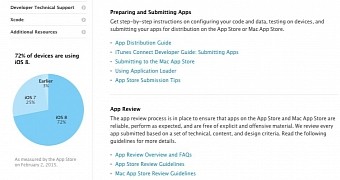Apple today reports that iOS 8 is currently installed on almost three quarters of iDevices, trailing iOS 7’s install rate by a few points.
iOS 8 didn’t enjoy a flawless start, but neither did iOS 7 in 2013. Avid iPhone fans will remember that iOS 7 was plagued by download errors. However, because iOS 8 did not enjoy the novelty factor that its predecessor did, any issues associated with the new firmware were taken far more seriously.
Slowing adoption rate
Compared to 2013’s figures, iOS 8 is currently behind about 10 percentage points. That’s not particularly concerning for Apple, whose customers perform regular software updates and can apply a new OS version within minutes, over the air (OTA).
The problem with iOS 8’s slower adoption rate is the bugs. Today’s iOS is one that has been associated with serious errors and even frozen devices, which was enough to put off some customers. There’s also the matter of device compatibility. For example, iPhone 4 users cannot install iOS 8.
We suspect that the main reasons behind this year’s dampened upgrades are: the similarity between iOS 7 and iOS 8, user commodity, and the lack of new features that make the experience worthwhile for regular customers (novelty features).
iOS 9 could tell us more
Like with its iPhone hardware, Apple radically retools iOS once every few years. If history is any indication, 2015 should mark the release of a significantly different iOS 9, but there’s no guarantee of that unfortunately.
iOS 9 should be unveiled at Apple’s Worldwide Developers Conference (WWDC) in the June-July timeframe alongside an all-new version of the company’s desktop operating system, OS X.
The public release – for both pieces of software – generally occurs in the fall period. The Cupertino company will also have a new iPhone ready for us by then. Keep your fingers crossed for a redesign in that department as well (think iPhone 7).

 14 DAY TRIAL //
14 DAY TRIAL //